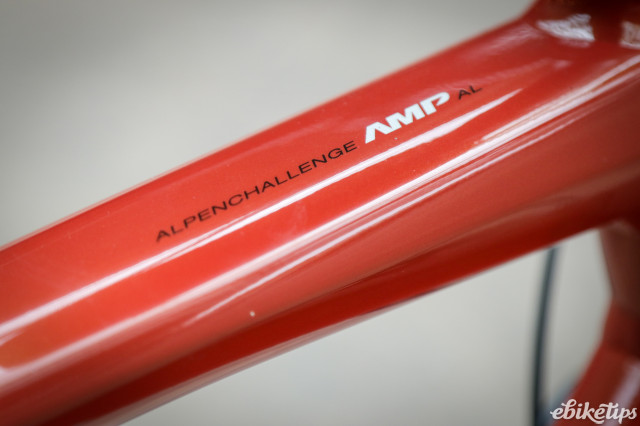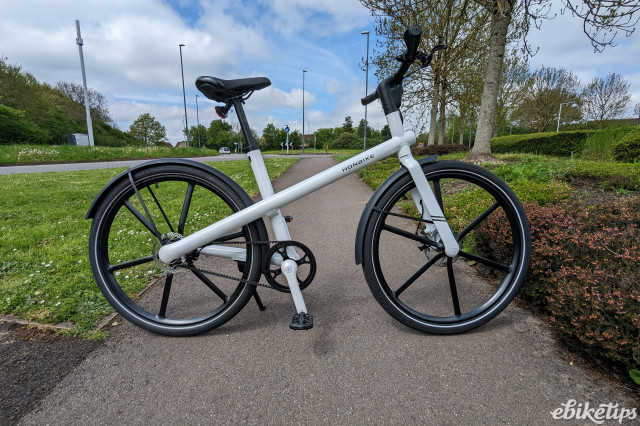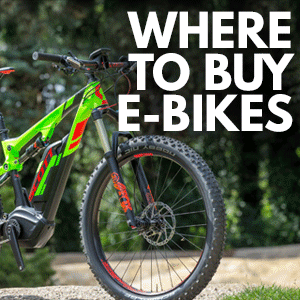Review: BMC AlpenChallenge AL Sport One
Overview
- Looks good
- Smooth, uncomplicated ride
- Battery could be bigger for the price
If you’ve ever sat on a bike, looked down and seen very few controls, yet felt this is exactly the number you need and no more, then you already know what it’s like to sit on the snappily named BMC Alpenchallenge AMP AL Sport One.
The AMP AL Sport gives the nice feeling of riding along and not worrying that you need to add something to the bike. Most of the moving parts are Shimano, with a nice set of 160mm Metrea disc brakes and just enough gears to adjust your cadence when faced with a slope, with a Rapidfire shifter on only the right-hand side. The motor (our old friend the Shimano E-6100) is in the middle, nested largely in front of the bottom bracket, puts out 250W, and generates so little hum you won’t hear it over the road noise.
The battery sits directly above it, at the bottom of the downtube with all its cables hidden away, keeping the centre of gravity low and masking the interesting bits behind your legs as you ride it - the AMP AL Sport doesn’t shout ‘I’m an ebike!’ as a result, although the livid orange colourscheme (‘amber’, apparently) ours came in still calls out for attention. There’s a kickstand, and our review model came with mudguards, a phone holder, and front and rear lights too, although those aren’t included with the stock bike. Like we said - everything you need, nothing extraneous. Maybe it could do with a bell.
The AMP AL Sport has a chunky aesthetic, looking like it wouldn’t collapse under a heavy rider yet managing to be light enough (18kg) to lift on and off a car rack with relative ease. The pedals are flat and broad, but the riding position keeps you hunched over the handlebars a bit too much for my liking. While on many city and leisure e-bikes you’ll get an adjustable stem that’s easy to tweak for a raised position, here it’s a standard Aheadset system which relies on spacers for its positioning and can’t easily be raised.
The forks are very straight, and there’s no suspension to be found, which can lead to a hard ride. We found the (non-stock) 32mm Panaracer road tyres on our test bike were good enough to mitigate that, as it’s not a bike you’ll be riding over ploughed fields. Not too often, anyway. The stock tyres are 32mm Vittoria Zaffiros, which offer a similar amount of cushioning. If you’re planning to head further from the tarmac then BMC also offers the Alpenchallenge AMP in a Cross build with 42mm WTB Resolute off-road tyres. My comfort wasn’t helped at at all by the ironically-named (for me) Selle San Marco SuperComfort saddle the test bike came fitted with. It’s not the stock saddle - that’s from Selle Royal - and a saddle is easily changed if you don’t get on with it.
The LCD screen is small, but well backlit and tells you what you need to know - how fast you’re going, how far you’ve been, and what time it is. The power comes in three levels - Eco, Mid and High, the display putting out a noticeable beep as you switch between them - and you can turn it completely off without feeling as if you’re fighting the motor’s resistance. The assistance comes in smoothly as you pedal, with no sharp drop-off when you hit the 15.5mph limit, and the gearing is nicely positioned (11-34T) so you feel like you’re still actively riding a bike rather than holding on while it does its own thing.
One niggle is that, for us, the power socket is on the wrong side. You approach a bike from the side with the kickstand, which means having to reach around it with the charging cable and put the plug in the socket blind. This could of course be solved by simply walking to the other side of the bike, but if you’re storing it against the wall in a garage it’s more likely to become an issue, and in long-term ownership being able to unplug and kick away the stand from the same side of the bike would be ideal. A minor complaint, but one nonetheless.
Range depends on so many things - rider weight, terrain, amount of time spent lazily scudding along in High rather than Eco mode - but we can easily believe the 60-mile claim made by the manufacturer, though for the price it would be nice to see Shimano’s newer 630Wh battery rather than the more standard 504Wh unit. Eco mode was enough assistance for going along the flat, and were we a little fitter we might have used it up gentle hills as well. As it was, we shifted into High only for the longest or steepest of upslopes.
This is a well-made ebike that we can imagine being a good long-term companion on commutes, trips to the shops, or for getting out and about at weekends. It comes with exactly what you need (apart from some items in the comfort department, which are highly subjective anyway). It looks good too, the orange paint adding to its appeal as long as you don’t want your bike to be unobtrusive.
Then there’s the price. Convert directly from the manufacturer’s price in Swiss Francs and you’re looking at somewhere in the £2,500 ballpark. However, as shortages and newly-imposed import red tape apply their thumb to the scales, e-bikes have got more expensive in the UK and this one is no exception, sporting a £3,150 tag. It’s a price many will baulk at paying for a bike, even one of this quality, but it’s still slightly cheaper than the Ridgeback Advance, and to our mind nicer to look at, even if it does lack that model’s front suspension. For a bike you can ride every day, however, the AMP AL Sport will do very nicely indeed.



























